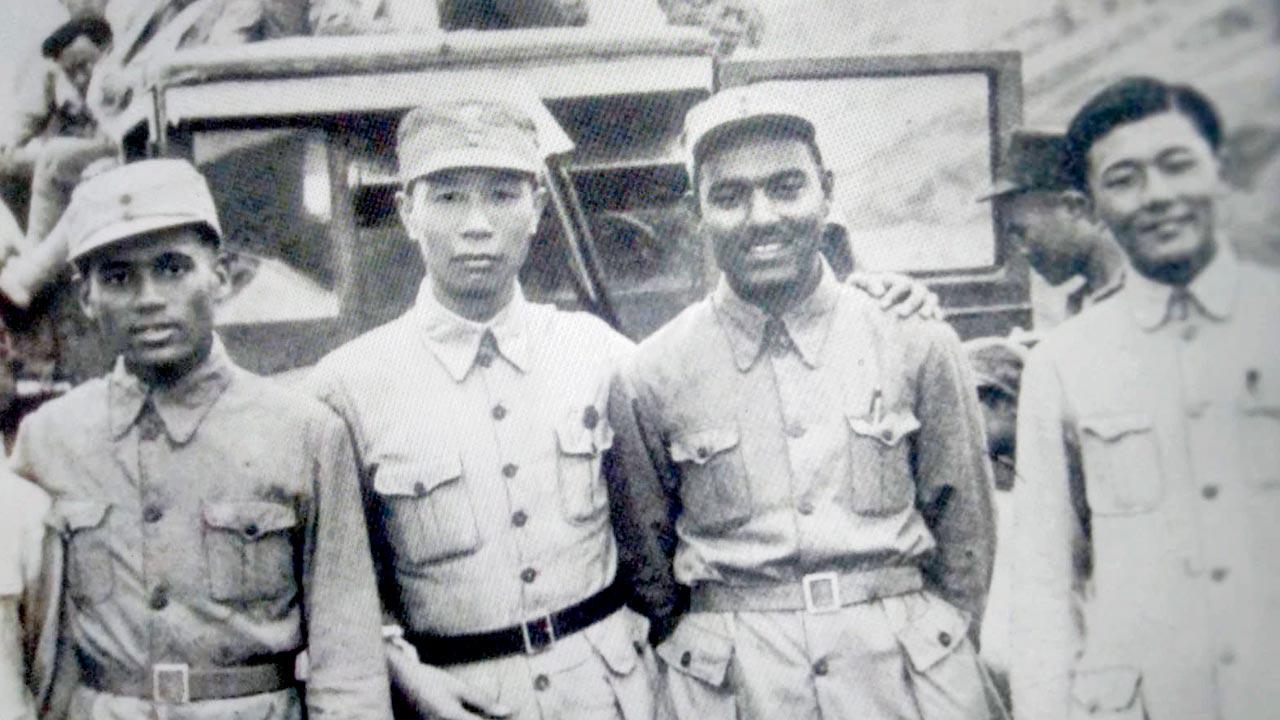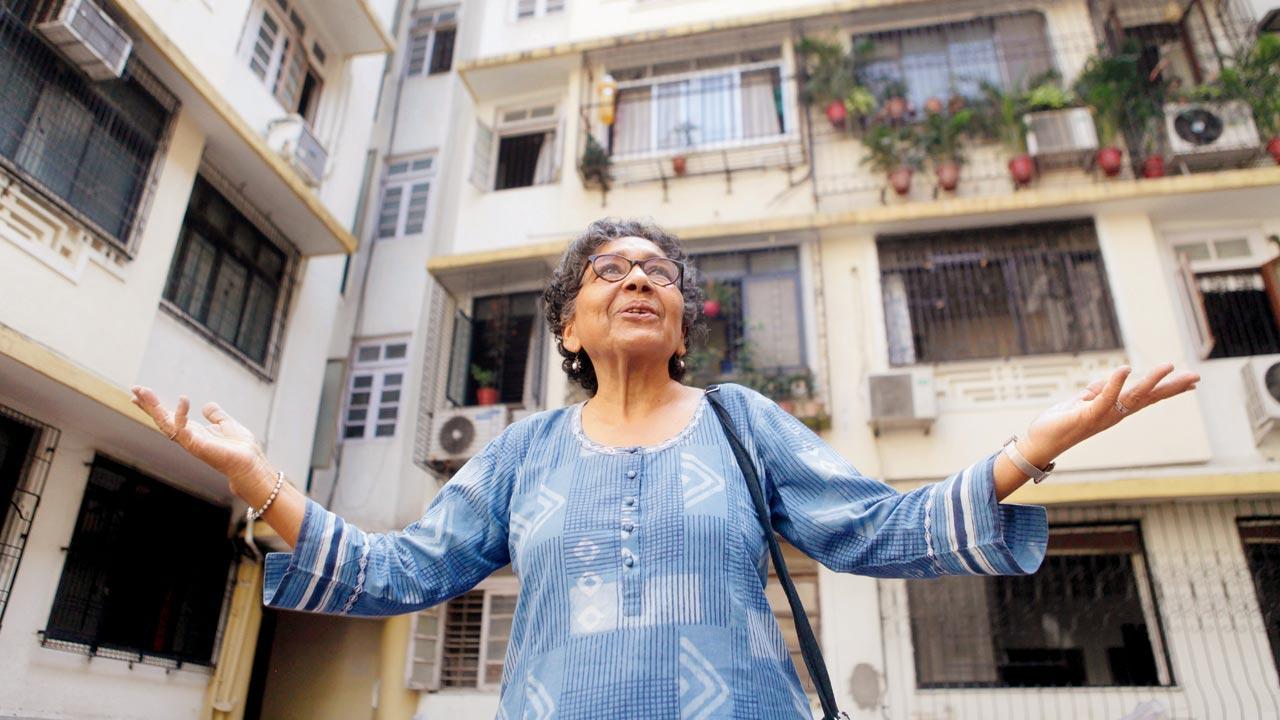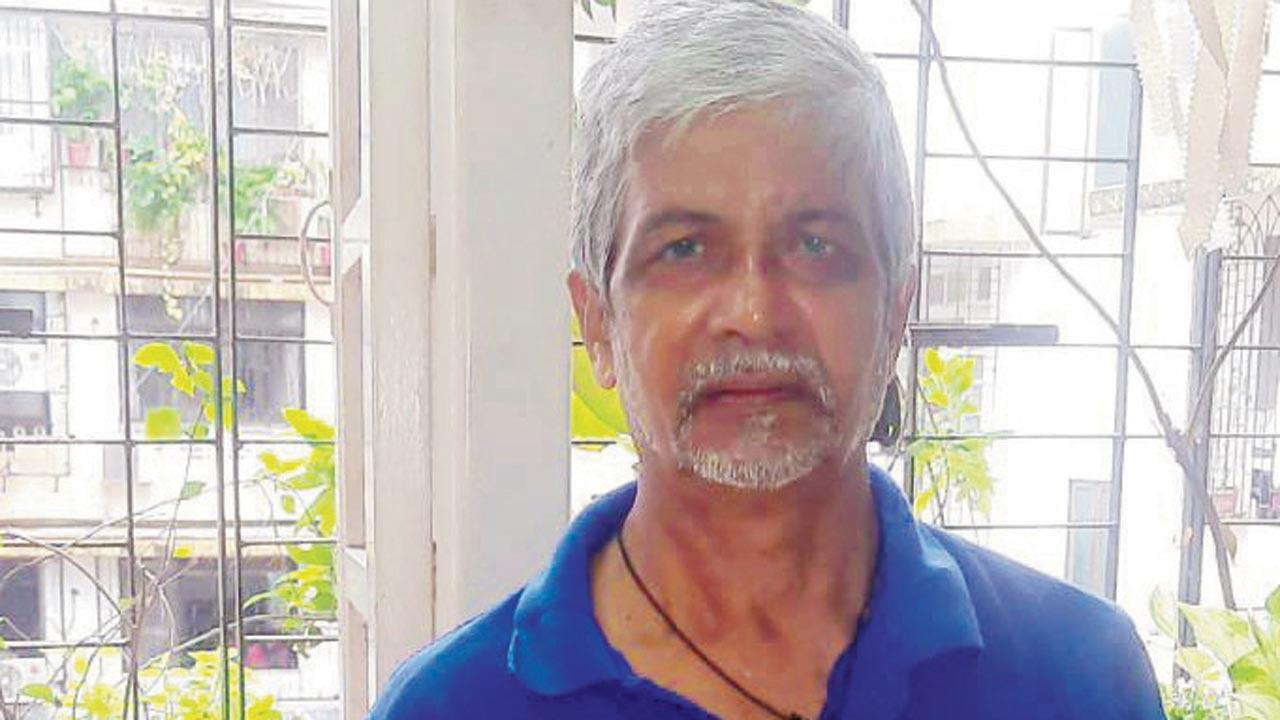Nestled quietly near Kennedy Bridge, Model House has been a cultural cradle grooming some of the finest artistry seen

Jayamala Joshi (right) with Jayesh Sohoni and his sister Shubha, on the only open balcony left in the colony. Pic/Ashish Raje
 On a bleak grey morning, cold winds swirl overhead and rain water pools around the ankles. But entering these gates warms me. I realise it is the gift of well-worn colony life. Inhaling an assortment of aromas from different breakfasts being prepared, I savour a vital buzz which envelops Model House. The complex of six blocks, A to E, laid in roughly horseshoe-shaped formation, has brilliantly catalysed art and culture in the city since its construction in 1941, on Proctor Road, off Lamington Road.
On a bleak grey morning, cold winds swirl overhead and rain water pools around the ankles. But entering these gates warms me. I realise it is the gift of well-worn colony life. Inhaling an assortment of aromas from different breakfasts being prepared, I savour a vital buzz which envelops Model House. The complex of six blocks, A to E, laid in roughly horseshoe-shaped formation, has brilliantly catalysed art and culture in the city since its construction in 1941, on Proctor Road, off Lamington Road.
ADVERTISEMENT
Mapping this east Grant Road precinct for these pages a few years ago, with some serendipity I had bumped into a third-generation resident with wonderful family history, who guided me with initial information. This time, over hot herbal tea she brews for us in her cosy kitchen, Jayamala Joshi explains how her grandfather, labour reformist and journalist Narayan Malhar Joshi, was among the first to move into freshly erected Model House in 1942, after retiring as a leading light of Gopal Krishna Gokhale’s Servants of India Society. He also founded the Social Service League, All India Trade Union Congress and Trade Union Federation, propelling landmark enactments on worker welfare. NM Joshi Marg in mill-hearted Parel commemorates his closeness to the labour class.
 Dr Dwarkanath Kotnis and Dr Vijaykumar Basu (first and third from left) with Chinese colleagues. Pic Courtesy/Dr Sumangala Kotnis Borkar
Dr Dwarkanath Kotnis and Dr Vijaykumar Basu (first and third from left) with Chinese colleagues. Pic Courtesy/Dr Sumangala Kotnis Borkar
The daughter of NM Joshi’s son Vasant Narayan, Jayamala shares a copy of Heritage of Model House: 1941 to 2011. This invaluable compilation, by SD Talgeri, chief vigilance officer of the Union Bank of India, tracks a vibrant trajectory. Erected during World War II, the new enclave was not fully occupied in the initial months. Prospective tenants feared Bombay’s bombing by Japanese planes, the way Fort Williams on the Madras coast had been targeted.
Sixty-five families slowly came forward seeking flats in the then three-storeyed buildings owned by the Model House Ltd. A fourth floor raised in 1948-49 provided further accommodation and 1970 saw the establishment of the Jai Model House Cooperative Housing Society Ltd. As we chat, I am introduced to Jayesh Sohoni from flat A 7, the sole home still uniquely skirted by its original open balcony. As if to figure what the fuss is about, a day after we photographed it, a monkey wandered in from this balcony, causing mayhem with mangoes he obviously thought smelt delicious.
 Veteran journalist Kalpana Sharma in the central compound of Model House. File pic
Veteran journalist Kalpana Sharma in the central compound of Model House. File pic
Starting out as a Chitrapur Saraswat Colony, Model House included the Talgeri, Surkund, Hemmadi and Amlady clans, followed by Gaud Saraswat Brahmins like the Nadkarni, Aras, Varde, Diwadkar, Gaitonde, Kamat, Sohoni, Vijaykar, Salgaonkar, Wagle, Rangnekar and Sanzagiri families. The Konkani-speaking Saraswats were joined by Marathi-speaking Naiks, Mayekars, Barves, Gurjars, Phataks, Samants, Padhyes and Joshis. The first Gujaratis were Munshis and Mehtas. With the D’Souzas and Wachhas, Christians and Parsis, they made Model House a cosmopolitan unit, each community lending its own expertise and flavour.
“I’m struck by Model House symbolising what was best about Bombay,” says journalist Kalpana Sharma, who lived till she was two in the C block flat which
was her parents’ first home when they married. “It had two good schools, decent middle-class housing, three cinemas not far—Imperial, Novelty and Opera House—fresh vegetables sold in Kilin Lane connecting Proctor Road to Lamington Road, a police station on the main road, shops and restaurants within easy reach, Chowpatty beach and Grant Road station a short walk away. It is a real pity that multi-cultural, well-connected neighbourhoods like this are getting fewer today in the city.”
 Ratnakar Horambe, who keeps working after 50 years for resident families
Ratnakar Horambe, who keeps working after 50 years for resident families
Sharma’s uncle and aunt continued to live in that apartment once her father took on a job in the North. Spending holidays with cousins who went to Robert Money School next door, she recalls the circulating library on Lamington Road driving away boredom. “My brother and I first saw an ice-gola cart outside Model House. Despite our pleas, our mother wouldn’t allow us to eat one. My freedom fighter aunt, Jaya B Rao, secretary of the Mahila wing of the Bombay Pradesh Congress Committee, was quite a presence in the colony.”
Their C block flat was on the ground floor, as was that of the family of theatre director-actor Vijay Kenkre in D block, where his artist and actor father Damu resided. “I was in Kala Nagar, Bandra. My aunt’s Model House place was an open house. Main doors were left wide open everywhere, so children were in and out of each other’s all the time,” says Vijay, adding, “Though never a chawl, Model House combined this interesting mix: a feel of the society that it was and a Girgaum-type chawl. Just the most excellent neighbourhood to forge bonds. On the ground floor, we heard all kinds of conversations, even arguments and heated debates at society election sessions!”
The central courtyard was paved only around the 1980s, as kids earlier hitting marbles in the mud recollect—along with old favourites kho kho and atya patya, not forgetting rousing games of cricket which broke glass windows in every surrounding block. That central space was an active adda, the crucible sparking experimental theatre and epic productions alike, for which stalwarts of the ilk of Vijaya Mehta and Mohan Gokhale came here to rehearse.
Popular actress Bhakti Barve, or Lata as she was locally known (her name was Bhaktilata) and MG Rangnekar, founder playwright-director of Natya Niketan, encouraged colony youngsters to act and sing at nightlong Diwali programmes. The courtyard was lit grandly for performances people flocked to from further afield as well to watch.
The colony’s prodigious “bal kalakaar”, Barve gratefully acknowledged Damu Kenkre for her theatrical debut, in a 1997 article published in Lok Prabha, titled, Parisar aancha hrun (Debt of the environment). Vijay Kenkre admits, “Years after he mentored her, as his son, it was difficult for me to think of directing Bhakti Tai in Hello Inspector. She was a towering personality. Her five feet height appeared six feet tall on stage.”
SD Talgeri’s diligent documentation reads as a veritable dossier of notables who unassumingly contributed to wide-ranging professions. He begins with
NM Joshi, “the Anna Data of labourers, a relentless fighter for their rights and a great socialist, with his colleagues, VV Giri, SA Dange and SM Joshi.”
The radiance of a richness of legendary figures shone through Model House. DB Jog who sculpted in marble Gandhiji, Nehru, Sardar Patel and the statue of the revolutionary Vasudev Balwant Phadke, which stands near Metro theatre. Cinema poster painter MV Ramnathkar. Composer Keshavrao Bhole who scored the stirring music for Sant Tukaram. Jyotsna Bhole, the actress and skilled exponent of both semi-classical and classical music genres. Film playback singer and Padma Bhushan awardee Suman Kalyanpur (nee Hemmadi) whose rendition of bhav geet and bhakti geet has been as phenomenal.
Konkani drama writer Annaji Surkund, famed too as the composer of Yakshagana, the Kannada musical based on mythology, was the director of the Shamrao Vithal Cooperative Bank. DN Nadkarni, Free Press Journal editor-in-chief, conducted the first flag hoisting on the premises. PV Prabhu was the head of 20th Century Fox... the list stretches breathtakingly endless.
Reliving the joys of growing up in a colony of camaraderie, ad man Rajesh Rangnekar, whose father Dr RY Rangnekar, was a TB and chest specialist, says, “It was so much fun going en masse for 15 to 16 Ganpatis within the building, singing aartis and feasting on a variety of prasad. A highlight was cricket matches organised between us and neighbouring buildings around Congress House, like Sunder Sadan, Kennaway House and Hanuman Building. We always triumphed, of course. The fabric of Model House gradually altered after it became a society.”
Remember V Shantaram’s film Dr Kotnis ki Amar Kahani? Block F of Model House was where the family of this noble doctor lived after his tragic death in China in 1942. Solapur-born Dwarkanath Shantaram Kotnis participated in an extraordinary medical mission India extended China in 1938, aiding the reparation of soldiers during the second Sino-Japan War. Nehru received a letter for help from Commander-in-Chief Zhu De, of the Eighth Route Army. Though warned his volunteering could be fraught with danger, Kotnis stuck to his commitment with uncommon bravery.
The youngest of four medicos sailing aboard the SS Rajputana for a fortnight, he learnt the foreign language from fellow passengers on the voyage itself. Reaching their destination, he was able to communicate in broken Chinese. He saved the seriously injured while coping with gruelling operation hours, inclement weather and terrible terrain. Climbing 30 miles a day in blistering chill across bad hilly roads, risking capture on Japanese-occupied territory, he nursed back to recovery at least 800 wounded soldiers with courage and conviction. When the rest of the team returned to India, Kotnis alone stayed on. He succumbed on the warfront to an epileptic episode. It was in Model House that his Chinese wife Guo Qinglan celebrated the sixteenth birthday of their son, Ing Hua—meaning “flower of India and China”.
Going strong as the general factotum cleaning homes, washing vehicles, undertaking plumbing and other odd jobs in the colony, the lined face and hands of Ratnakar Horambe reveal a spirited innings of 50 years of hard work. He is proud of having “wiped the cars of stars like Shafi Inamdar” and, equally, of possessing a fridge and a washing machine in the Jogeshwari house he leaves at sunrise every morning. “I am on the 5.30 am train and reach at 6.15 am on the dot. You need no clock to tell the time when you see Ratnakar in Model House,” he quips. Reflecting on the alternating comfort and conflict that mark any housing cluster, he adds, “Aata thoda vegle hot chaalley, pun hey kharach tya veli model society hotey (things are changing a bit now, but this was truly a model of a building).”
Author-publisher Meher Marfatia writes fortnightly on everything that makes her love Mumbai and adore Bombay. You can reach her at meher.marfatia@mid-day.com/www.meher marfatia.com
 Subscribe today by clicking the link and stay updated with the latest news!" Click here!
Subscribe today by clicking the link and stay updated with the latest news!" Click here!







